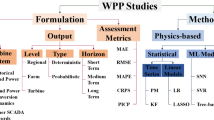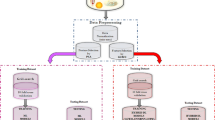Abstract
With the rapid development of wind power capacity and sustained growth in total operation time, the maintenance of wind turbines is becoming increasingly prominent, so we urgently need to develop effective wind turbine fault diagnosis and prediction system. The main fault characteristics of wind turbines are summarized from two aspects of fault diagnosis and fault prediction. Aiming at the difficult problems of fault diagnosis, we analyze and summarize the research status of fault diagnosis methods based on vibration, electrical signal analysis and pattern recognition algorithm. At the same time, we point out the technical characteristics, limitations and future trends of various methods. Based on the characteristics of mechanical structure and electronic system degradation in wind turbines, we summarize the current research progress and propose a fault prediction method based on physical failure model and data driven model fusion. In this paper, we use the deep learning model in the framework of the internet of things to predict and diagnose the faults of wind power generation. The experimental results show that the algorithm proposed in this paper can predict the fault types and make reasonable diagnosis.
















Similar content being viewed by others
References
Yin, M., Wang, C., et al.: Comparison and analysis of wind power development. Trans. China Electrotech. Soc. 25(9), 157–162 (2010)
Nie, Q.-W., Gao, W.: A power network fault diagnosis method based on data mining association rules. Power Syst. Prot. Control 37(9), 8–14 (2009)
Li, J., Li, G.-Q.: A survey on application of fault tolerant control in power system. Power Syst. Prot. Control 38(3), 140–146 (2010)
Yang, Z.-J., Wu, H.-B., Ding, M., et al.: Control strategy of doubly-fed wind generation system for power grid fault. Power Syst. Prot. Control 38(1), 14–18 (2010)
Hang, J., Zhang, J.-Z., Cheng, M., et al.: An overview of condition monitoring and fault diagnostic for wind energy conversion system. Trans. China Electrotech. Soc. 28(4), 261–271 (2013)
Han, A.-Y., Zhang, Z., Yin, X.-G., et al.: Research on fault characteristic and grid connecting-point protection scheme for wind power generation with doubly-fed induction generator. Trans. China Electrotech. Soc. 27(4), 233–239 (2012)
Dong, Y., Li, Y., Cao, H., et al.: Real-time health condition evaluation on wind turbines based on operational condition recognition. Proc CSEE 33(11), 88–95 (2013)
Wang, H., Wang, J.: An effective image representation method using kernel classification. In: 2014 IEEE 26th International Conference on Tools with Artificial Intelligence (ICTAI), pp. 853–858. IEEE (2014)
Energy Research Institute.: China wind energy development roadmap 2050. National Development and Reform Commission of P.R. China, China (2011)
Khan, U., Ahmed, N., Mohyud-Din, S.T.: Heat transfer effects on carbon nanotubes suspended nanofluid flow in a channel with non-parallel walls under the effect of velocity slip boundary condition: a numerical study. Neural Comput. Appl. 28(1), 37–46 (2017)
Zhang, S., Wang, H., Huang, W.: Two-stage plant species recognition by local mean clustering and Weighted sparse representation classification. Cluster Comput. 20, 1517–1525 (2017)
Caselitz, P., Giebhardt, J.: Rotor condition monitoring for improved operational safety of offshore wind energy converters. J. Solar Energy Eng. 127(2), 53–261 (2005)
Chen, X.F., Li, J.M., Cheng, H., et al.: Research and application of condition monitoring and fault diagnosis technology in wind turbines. J. Mech. Eng. 47(9), 45–52 (2011)
Ding, S., Zhang, N., Zhang, X., Wu, F.: Twin support vector machine: theory, algorithm and applications. Neural Comput. Appl. 28(11), 3119–3130 (2017)
Hayat, T., Khan, M.I., Waqas, M., Alsaedi, A.: Magnetohydrodynamic stagnation point flow of third-grade liquid toward variable sheet thickness. Neural Comput. Appl. (2017). https://doi.org/10.1007/s00521-016-2827-1
Liu, S., Fu, W., He, L., Zhou, J., Ma, M.: Distribution of primary additional errors in fractal encoding method. Multimed. Tools Appl. 76(4), 5787–5802 (2017)
Huang, W., Wang, H., Zhang, Y., Zhang, S.: A novel cluster computing technique based on signal clustering and analytic hierarchy model using hadoop. Cluster Comput (2017). https://doi.org/10.1007/s10586-017-1205-9
Wang, J., Li, T., Shi, Y.Q., Lian, S., Ye, J.: Forensics feature analysis in quaternion wavelet domain for distinguishing photographic images and computer graphics. Multimed. Tools Appl. 76(22), 23721–23737 (2017)
Bok, K., Hwang, J., Lim, J., Kim, Y., Yoo, J.: An efficient MapReduce scheduling scheme for processing large multimedia data. Multimed. Tools Appl. 76(16), 17273–17296 (2017)
Chen, Q., Zhang, G., Yang, X., Li, S., Li, Y., Wang, H.H.: Single image shadow detection and removal based on feature fusion and multiple dictionary learning. Multimed. Tools Appl. (2017). https://doi.org/10.1007/s11042-017-5299-0
Guo, J.: Smartphone-powered electrochemical biosensing dongle for emerging medical IoTs application. IEEE Trans. Ind. Inform. (2017). https://doi.org/10.1109/tii.2017.2777145
Liu, H., Bolic, M., Nayakand, A., et al.: Taxonomy and challenges of the integration of RFID and wireless sensor networks. IEEE Netw. 22(6), 26–35 (2008)
Englund, C., Wallin, H.: RFID in wireless sensor network, EX034/2004. Communication Systems Group, Department of Signals and Systems, Chalmers University of Technology, Sweden (2004)
Ahmad, A., Hanzálek, Z.: An energy efficient schedule for IEEE 802.15. 4/zigbee cluster tree WSN with multiple collision domains and period crossing constraint. IEEE Trans. Ind. Inform. 14(1), 2–23 (2018)
Zhang, S., Wang, H., Huang, W., You, Z.: Plant diseased leaf segmentation and recognition by fusion of superpixel, K-means and PHOG. Optik-Int. J. Light Electron Optics 157, 866–872 (2018)
Chen, M., Xiao, X., Guerrero, J.M.: Secondary restoration control of islanded microgrids with decentralized event-triggered strategy. Ind. Inform, IEEE Trans. (2017). https://doi.org/10.1109/TII.2017.2784561
Laserson, J.: From neural networks to deep learning: zeroing in on the human brain. XRDS Crossroads ACM Mag. Stud. 18(1), 29–34 (2011)
Cha, Y.J., Choi, W., Büyükztürk, O.: Deep learning based crack damage detection using convolutional neural networks. Comput. Aided Civ. Infrastruct. Eng. 32(5), 1–378 (2017)
Goldberg, D.E.: Genetic Algorithms in Search, Optimization and Machine Learning, pp. 2104–2116. Addison-Wesley, Reading (1989)
Author information
Authors and Affiliations
Corresponding author
Rights and permissions
About this article
Cite this article
Chen, F., Fu, Z. & Yang, Z. Wind power generation fault diagnosis based on deep learning model in internet of things (IoT) with clusters. Cluster Comput 22 (Suppl 6), 14013–14025 (2019). https://doi.org/10.1007/s10586-018-2171-6
Received:
Revised:
Accepted:
Published:
Issue Date:
DOI: https://doi.org/10.1007/s10586-018-2171-6




